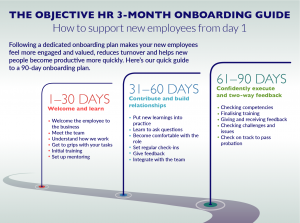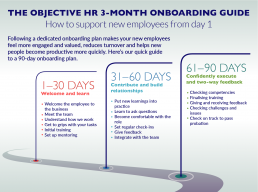The Objective HR 3-month onboarding guide
What does ‘onboarding’ mean to your business? For some, it’s about the first day – the first week at most. And then your new employee is expected to be up and running with the minimum amount of support.
But that’s not onboarding. That’s just bringing someone in and telling them to get on with it. Best practice onboarding is about spending time integrating new employees into the culture, processes and working practices of your organisation, giving them the time and support they need to get up to speed and work productively.
Why does it matter?
It’s a good question. And it’s easy to answer. Companies that have a good quality onboarding process tend to find that they:
- Improve retention
- Boost their employer brand
- Achieve greater productivity sooner
- Build a culture of support and open conversation
- Can use feedback to improve their processes
Of all these benefits, the ones that really matter to organisations are often retention and productivity. That’s because getting either of these things wrong costs money. It’s expensive to keep recruiting new people and training them, only to find they leave at, or even before, the end of their probation period.
And of course, you need your people to be productive. So, the more effort you put into designing a process that can help them feel confident and supported in their new role, the quicker you will reach optimum productivity levels.

Our 30-60-90 guide
When we work with clients, we use the 30-60-90 model. This encourages managers and HR professionals to see how a good onboarding process can work through the entire probation period. It allows both parties to feedback, learn and engage with each other, helping to build trust and employer brand loyalty.
Most importantly, it gives both the employer and the employee a simple structure to follow, with check-ins and measurements in place. This makes administering the probation period much easier, and lets the employee see exactly what’s expected of them – and what support they will be getting.
We’ve put our guide into this handy infographic – if you’d like to talk to us about how to implement this, or any other HR policies and culture design into your organisation, just contact us today.

